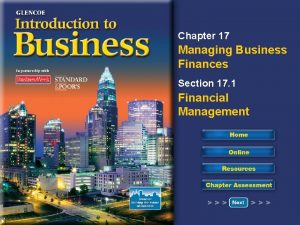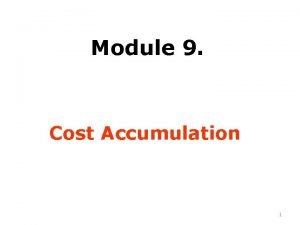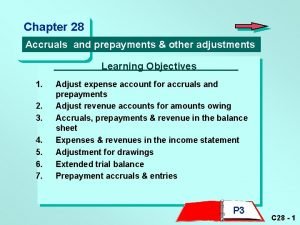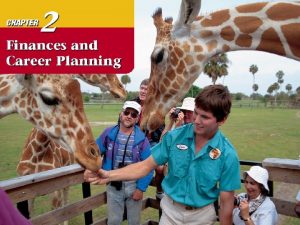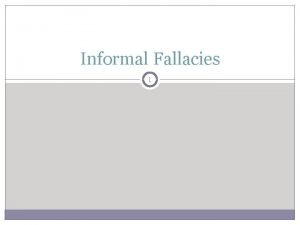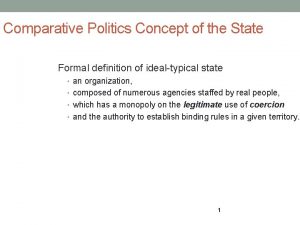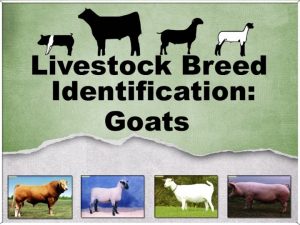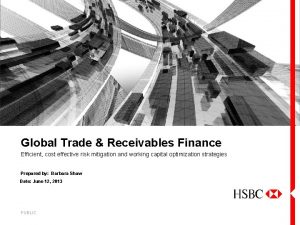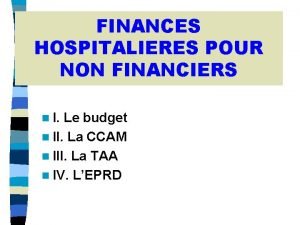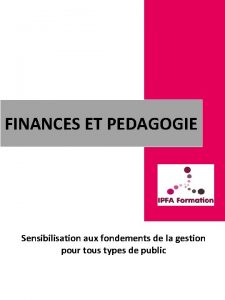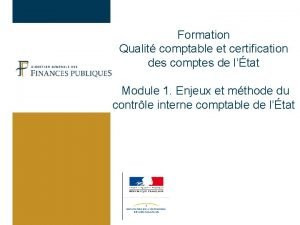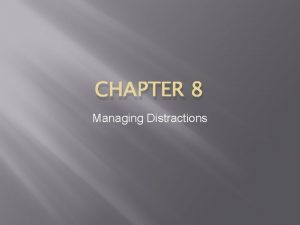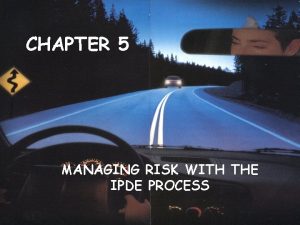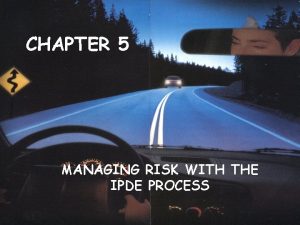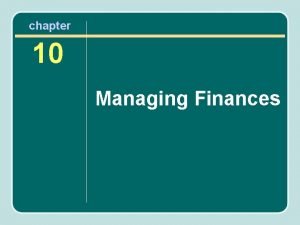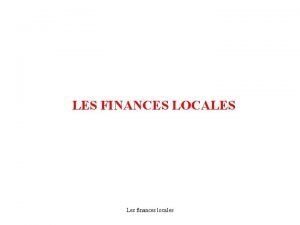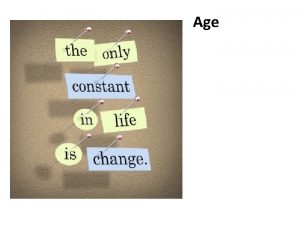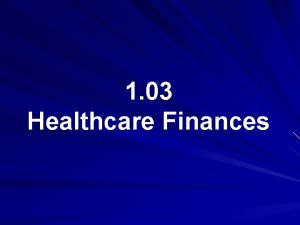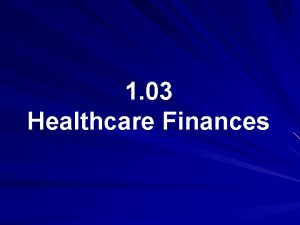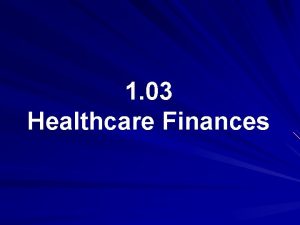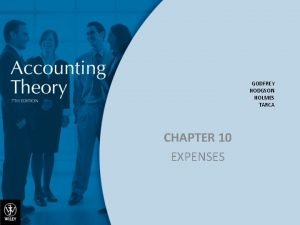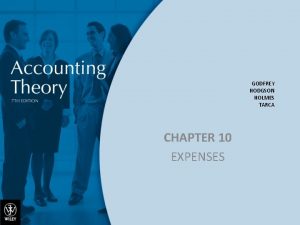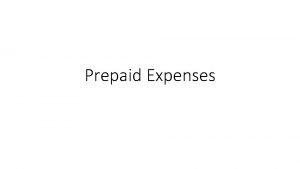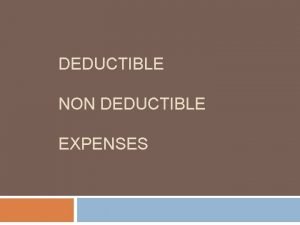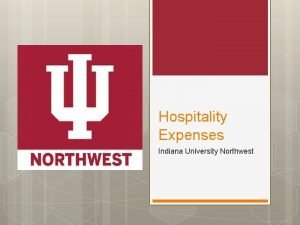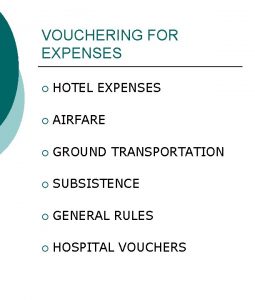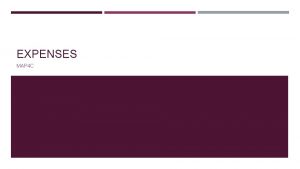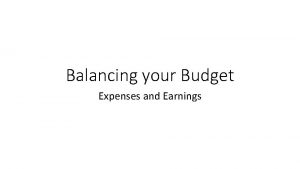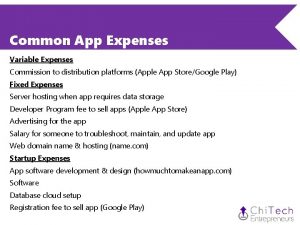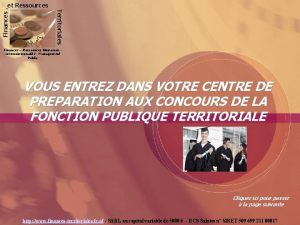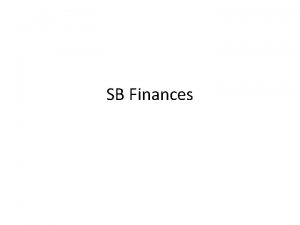chapter 10 Managing Finances Expenses Numerous expenses have





























- Slides: 29

chapter 10 Managing Finances

Expenses • Numerous expenses have an impact on recreation facility management. • A large percentage of all recreation agency expenses revolve around facilities and their employees, maintenance, utilities, repair, and renovation expenses. • Typical recreation facility expense categories can be broken down into two broad categories: structural expenses and support expenses.

Structural Expenses • The presence of a recreation facility as a structure creates structural expenses. • These are expenses associated with maintaining or improving the physical structure of the facility and can include repair, renovation, and retrofitting. • In addition, structural expenses can include loan or mortgage, depreciation, taxes, reserve, and insurance expenses.

Repairing, Renovating, and Retrofitting • Over time, facilities and equipment deteriorate, no longer fulfilling their original purpose. • When this occurs, expenses are incurred to keep them functional.

Loan or Mortgage • One of the greatest ongoing expenses for recreation facilities is the monthly or quarterly loan or mortgage payments for construction or purchase of a facility. • This arrangement can be in the form of a bank loan or bond payment and commits management to repay the debt for the purchase or construction of a recreation facility over a predetermined length of time.

Depreciation • As soon as a recreation facility or piece of equipment is purchased, it begins to lose value. • The decrease in value of recreation facilities and equipment by a certain percentage each year is called depreciation. • The amount depreciated can be recorded as an expense for tax purposes.

Taxes • Public recreation facilities may be exempt from paying certain taxes on income generated from a product or from paying property taxes. • Private facilities can be at a serious disadvantage when they are in direct competition with a public recreation facility that has tax support as income in addition to not paying taxes due to its public status.

Reserve Fund • In order to protect against having to spend funds from the daily operational cash flow, a reserve is created as an expense management category. • A reserve fund is a sound fiscal practice of setting aside money for potential facility problems.

Insurance • Insurance should cover potential losses for management with a policy that defines the conditions for coverage. • Several categories of insurance may be necessary at any given recreation facility. – – Liability insurance Accident insurance Worker’s compensation Property damage or theft insurance

Support Expenses • The second general expense category includes costs that support operations. • It includes expenses associated with employees, maintenance, equipment, utilities, and contractual services.

Employees • One of the greatest recreation facility expenses is labor costs. • Several expenses are created by the people who keep facilities and equipment functional, including: – – – Salary Hourly wages Payroll taxes Benefits Training Professional Development

Maintenance • Allocating adequate funds to support maintenance is paramount. • Some recreation agencies consider facility maintenance as one of the most important aspects of presenting their product. • Proper maintenance of recreation facilities and equipment is not only a serious consideration to the comfort and efficiency of product delivery, but it also contributes to facility and equipment longevity by preventing unnecessary wear and tear.

Equipment • A primary responsibility of recreation administrators is budgeting funds for the purchase and care of all equipment. • There is an extensive array of items, objects, and equipment within a recreation facility that can vary greatly in cost.

Utilities • Virtually no recreation facility can function without access to water and electricity, or utilities. • Each utility represents an expense category that usually has to be paid for on a monthly basis. • Recreation facility managers must maximize the use of a facility and scrutinize the utilities to minimize their cost where possible.

Contractual Services • Another facility expense category is outside contractual services that assist with facets of the facility that cannot be managed internally. • Typical contractual services include repairs to HVAC systems, janitorial services, garbage removal, landscaping, design assistance, consultant assistance, and snow removal.

Income • In order for a facility to be viable, income must be generated by the facility. • Income generation is critical to the success of recreation facility managers in delivering the core product to the user. • Many decisions regarding the delivery of a recreation product revolve around pricing the core product and core product extensions and the ability for those products to generate income.

Income Categories • Income generated can be viewed in two categories: gross income, which is the total amount of money generated over a specified amount of time, and net income, which is the remaining funds after all expenses, including taxes, have been paid. • Net income is also known as profit, which is the primary source of revenue for private recreation entities.

Sources of Income Fees & Charges • Many ways of collecting income through fees and charges relate to the purpose of the recreation facility and the desire for users to access a product. • Fees and charges can come from: – – – Ticket sales User fees Membership fees Activity fees Retail outlets

Sources of Income Rentals • Some recreation facilities may present the opportunity for income generation by renting space or equipment. • Renting is an option when interest exists to use space or equipment and customers are willing to pay a rental fee.

Sources of Income Donations • Many recreation agencies create an interest in and image of their facility that results in an opportunity for donations. • If a recreation agency appeals to a community, particularly if it provides services for young people, financial support through donations may be an option.

Sources of Income Investors • An individual or group of individuals with adequate financial resources, or investors, can provide funds for a recreation facility project in the hope of eventually receiving a dividend on their investment. • Investors have a percentage interest in a for -profit recreation facility.

Sources of Income Investments • Recreation administrators can invest excess cash in marketable securities to generate income. • Investments can be short term or long term in the form of interest on bonds and notes or dividends on shares of stock. • Investment strategies should be investigated thoroughly before implementation.

Sources of Income Sponsorships • This form of fiscal support usually results from cooperative interests between two agencies, both looking to gain something from the sponsorship. • Usually a sponsor offers financial resources to help with expenses in exchange for access to advertising space or promotional exposure.

Sources of Income Tax Support • Most public recreation agencies depend on some type of income from local, state, or federal taxes. • The general funding philosophy of taxsupported facilities is that the facility serves the needs of the community. • Tax support is highly political and evolves from political leadership that can persuade government entities to fund a public need.

Fiscal Practices • In addition to having an understanding of expenses and sources of income in delivering the product, recreation facility managers must also organize and present systems for managing finances. • The most common fiscal practices for managing finances include budgeting, accounting, and cost analysis.

Fiscal Practices Budgeting • Budgeting can be described as a systematic effort to project all income and expenses for a given length of time. • Most recreation agencies budget in yearly cycles, submitting budget projections to the administration 3 to 6 months before a new fiscal year. • The fiscal year is a 12 -month cycle, which does not necessarily correspond with a calendar year, during which a recreation agency determines and monitors its financial condition.

Fiscal Practices Accounting • Part of the budget process requires ongoing record keeping of income and expenditures, or accounting. • Accounting practices are usually done by an accountant or fiscal officer in the organization and involve generating reports on a monthly, quarterly, and annual basis. • These reports reflect specific income and expense categories and are often compared with data from the previous year, other time frames within the year, or a predetermined budget that outlines management expectations

Fiscal Practices Cost Analysis • Cost analysis is the process of comparing and analyzing costs associated with delivering a recreation product in an effort to determine the true costs of delivering the product and applying ways to save money. • Ultimately the cost analysis results in recommendations to reduce operational costs and provide savings.

Assignment 1. Describe the primary income categories at your facility. 2. List two (2) different structural expense categories of your facility? 3. Describe and list two (2) of the support expense categories of your facility.
 Chapter 17 managing personal finances
Chapter 17 managing personal finances Chapter 17 managing business finances worksheet answers
Chapter 17 managing business finances worksheet answers Managing your personal finances textbook answers
Managing your personal finances textbook answers Direct vs indirect expenses
Direct vs indirect expenses Accrual and prepayments
Accrual and prepayments Chapter 11 finances and career planning
Chapter 11 finances and career planning Chapter 4 finances and career planning
Chapter 4 finances and career planning Describe factors that affect your potential earning power
Describe factors that affect your potential earning power Missing the point
Missing the point A cell with chloroplasts is probably specialized for
A cell with chloroplasts is probably specialized for Short numerous hairlike projections for movement
Short numerous hairlike projections for movement Definition of numerous
Definition of numerous What organisms are most numerous on earth?
What organisms are most numerous on earth? Numerous variety
Numerous variety Which ethnic group is most numerous in southwest asia
Which ethnic group is most numerous in southwest asia Internal sources of finance examples
Internal sources of finance examples Receivables finance risk reduction
Receivables finance risk reduction Understanding your business finances
Understanding your business finances Finances hospitalieres
Finances hospitalieres Finances et pedagogie
Finances et pedagogie Echaustif
Echaustif 6 square faces 8 vertices 12 edges
6 square faces 8 vertices 12 edges Chapter 1 managing risk when driving
Chapter 1 managing risk when driving Chapter 8 managing stress and anxiety
Chapter 8 managing stress and anxiety Leasiest
Leasiest Distractions outside the vehicle are more easily managed
Distractions outside the vehicle are more easily managed Chapter 8 managing distractions answers
Chapter 8 managing distractions answers Chapter 6 managing weight and body composition
Chapter 6 managing weight and body composition When you apply the ipde process
When you apply the ipde process Ipde process examples
Ipde process examples
